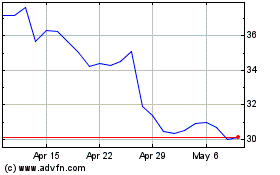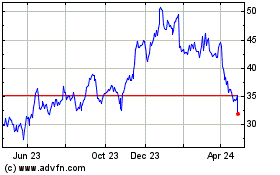U.S. Invests $258 Million in Supercomputing Race With China
June 15 2017 - 2:29PM
Dow Jones News
By Rachael King
The U.S. government is trying to stave off China and other
countries challenging the U.S. for dominance in the next generation
of the world's fastest computers.
The Department of Energy on Thursday said it would award $258
million over three years to be shared by six tech companies, as
part of a plan to develop new supercomputers that can crunch data
at least 50 times faster than the nation's most powerful systems
today.
The companies are Advanced Micro Devices Inc., Cray Inc.,
Hewlett Packard Enterprise Co., International Business Machines
Corp., Intel Corp. and Nvidia Corp.
U.S. government leaders warned in a September 2016 technical
meeting convened by the National Security Agency and the DOE that
the country was in danger of losing its leadership in
supercomputers to China. Governments have long used these systems
to crack codes and develop nuclear weapons, and the supercomputers
have business purposes such as oil exploration and auto design.
The U.S. is in a "horse race" with China, the European Union and
Japan as they attempt to outdo one another in processing power,
said Steve Conway, senior vice president of research at Hyperion
Research.
The fastest U.S. computer, the Titan, built by Cray, can handle
17,590 trillion calculations per second, or the rough equivalent of
11.6 million iPad Pros running at the same time. It is about the
size of a basketball court and is said to use enough power to run a
small town.
By 2021, the U.S. plans to deliver at least one "exascale"
system which performs one quintillion -- a billion billion --
calculations per second. That would be one year later than when
China has said it plans to deploy its first system. Both countries
are anticipated to deliver production-ready systems that can solve
problems at exascale speeds by as soon as 2023, according to
Hyperion Research.
In June 2016, China took the top spot in a twice-yearly ranking
of the 500 fastest scientific computers. China's machine, called
the Sunway TaihuLight, marked the first time China had taken the
top speed ranking without using U.S. semiconductor technology.
China also, for the first time, placed more machines than the U.S.
on the so-called Top 500 list, by 167 to 165. In a November 2016
ranking, the U.S. and China each had 171 systems on the list.
The DOE funding will be used by the tech companies to further
the research and development into exascale computers. Hewlett
Packard Enterprise, for example, last month demonstrated a
prototype of a new memory-driven computer called The Machine, which
it will further develop with the additional funds by the
government. The system is HP Enterprise's largest research and
development program in the history of the company. That computing
system is capable of simultaneously working with the data held in
every book in the Library of Congress five times over, about 160
million books.
Hyperion Research estimates that the price to research, develop
and buy a U.S. exascale system will total about $300 million to
$500 million per system. Oak Ridge National Laboratory spent about
$97 million to buy the Titan supercomputer from Cray. While the
U.S. government is typically the first buyer for these systems, the
technology advances usually trickle down to other computing
products at lower prices.
Write to Rachael King at rachael.king@wsj.com
(END) Dow Jones Newswires
June 15, 2017 14:14 ET (18:14 GMT)
Copyright (c) 2017 Dow Jones & Company, Inc.
Intel (NASDAQ:INTC)
Historical Stock Chart
From Mar 2024 to Apr 2024

Intel (NASDAQ:INTC)
Historical Stock Chart
From Apr 2023 to Apr 2024
